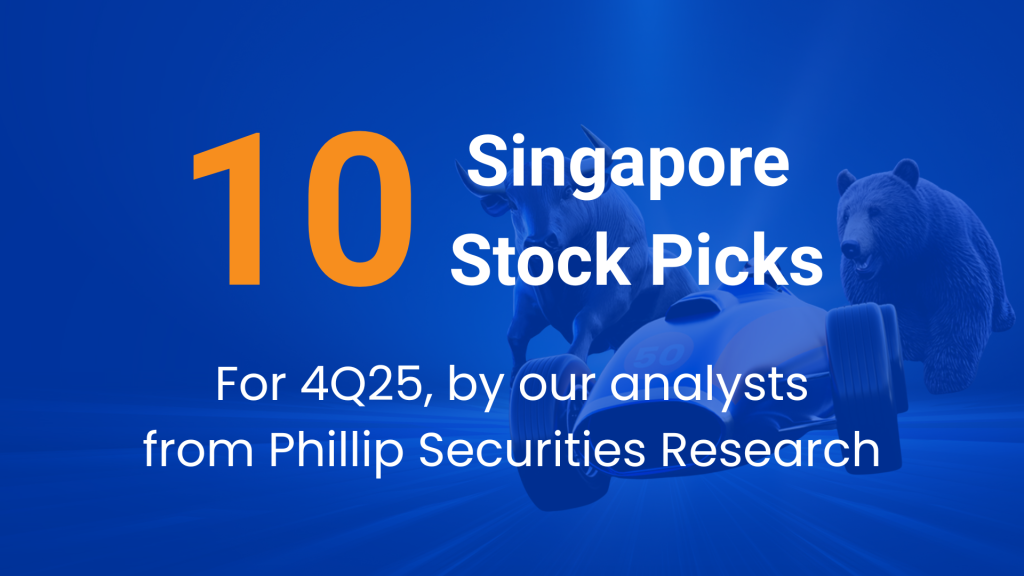- Home
- Singapore Stock Picks 4Q2025

Subscribe to our newsletter for
investing in stocks
Financial
Prefer DBS for its substantial deposit and CASA growth, as well as effective hedging, which has maintained NII. DBS is the only SG bank paying a fixed DPS and has the highest dividend payout ratio.
Property/REIT
A mix of stable and growth sources of income, as well as geographical diversification. CLAS has over S$300mn in prior divestment gains, which could be used to offset the absence of contributions from assets undergoing AEIs.
A mix of stable and growth sources of income, as well as geographical diversification. CLAS has over S$300mn in prior divestment gains, which could be used to offset the absence of contributions from assets undergoing AEIs.
Prime is also in advanced negotiations to secure over 150k sft (3.5% of NLA) of space, with portfolio occupancy expected to recover to 85% by end 2025. Share price is trading at 0.4x P/NAV with forward yield of 7%
Portfolio rental reversions in 2H25 are expected to return to mid-single digits, led by lease renewal at Haagse Poort. As vacated spaces are backfilled, portfolio occupancy is projected to rise to approximately 94%. Yield of around 9%.
Strong take-up rates of launched projects, together with the accelerated pace of capital recycling/divestments, may help narrow the 46% discount to our RNAV of S$12.82.
Conglomerate
A pool of S$14.4bn assets to be monetised with a S$500mn share buyback programme underway. FY26e will be a year of growth from new office building, power plant, and Bifrost cables.
Completion of the US$170mn infrastructure will boost mine production from 2mn to 12mn by FY27e, generate toll revenue from 25m MT road capacity, and river transhipment fee from tugs and barges to be acquired.
Construction order book spiked by 90% YoY from HDB BTO contract wins, which will last till 2029e. An additional 7,400 worker dormitory beds are expected to be completed by 4Q25e, increasing existing bed capacity by 47%.
Telecom
Most countries have a clear line of sight for mobile price repair. Value realisation (or medium-term special) dividends are likely to be at the higher end of the 6-cent range, given the larger pipeline of assets to monetise.


To view the recording of our Singapore Outlook 3Q2025 webinar, please visit:
@PhillipCapital

To view the recording of our Singapore Outlook 3Q2025 webinar, please visit:
@PhillipCapital

FAQ
Embark your stock trading journey by opening an Account with POEMS. Explore the step-by-step guides and video tutorials on navigating POEMS 2.0, POEMS Mobile 3.0 and POEMS Pro here.
“BUY”: A “BUY” recommendation indicates that the analyst believes the stock is likely to increase in value over time and that investors should consider purchasing it. This recommendation often suggests the stock is undervalued or expected to perform well in the near future.
“ACCUMULATE”: This recommendation implies that the stock is anticipated to rise in value but may already have experienced some price appreciation. Analysts recommend gradually buying shares over time, particularly if the stock is trading at a higher price.
“SELL”: A “SELL” recommendation signals that the analyst expects the stock’s value to decrease or considers it overvalued. Investors are advised to sell to avoid potential losses.
The stock recommendations are updated on a quarterly basis.
Key Differences Between Short-Term and Long-Term Investing:
Aspect | Short-Term Investing | Long-Term Investing |
Time Horizon | A few months to a couple of years | Several years to decades |
Objective | Capitalisze on short-term market movements | Build wealth over time with compound growth |
Strategy | Active trading, speculation, reacting to market events | Buy and hold, growth, value, or dividend investing |
Risk | Higher risk due to market volatility and unpredictability | Lower risk over time, though still subject to market fluctuations |
Returns | Potential for quick, but often volatile returns | Steady, compounding returns over a longer period |
Liquidity Needs | High liquidity, able to buy/sell quickly | Lower liquidity, funds are typically tied up for longer periods |
Market Sensitivity | Highly sensitive to short-term news, events, and trends | Less sensitive to short-term fluctuations; focused on long-term fundamentals |
There is no fixed formula but a combination of future earnings growth, valuations, balance sheet strength and attractiveness of the business model.
Analyst stock recommendations are based on their individual views, assumptions, and forecasts, which may differ from actual outcomes, potentially impacting share prices. The types of stocks recommended may not align with your personal financial objectives. It is important to understand the investment rationale and financial assumptions behind any analyst recommendation before making a decision.
When choosing stocks to invest in, it’s important to evaluate the company’s fundamentals, such as earnings growth, profit margins, debt levels, and cash flow, as well as its valuation using metrics like P/E ratio and P/B ratio. Consider the industry outlook, including trends, competition, and regulatory risks, and assess the company’s management and governance.
Diversification is the strategy of spreading investments across different stocks, sectors, or asset classes to reduce risk. By holding a variety of investments, you minimise the impact of any single asset’s poor performance, as losses in one area can be offset by gains in another. This helps smooth out volatility, improve the consistency of returns over time, and protect against unforeseen risks, such as market downturns or company-specific issues.
There are two methods to find your portfolio. You can either head to the ‘Me’ Tab > Select ‘Portfolio’ or head to the ‘Trade’ Tab > Select ‘Positions’ > Select ‘Holdings’.
A stock’s target price is an analyst’s estimated price level for the stock over the next 12 months, based on their evaluation of the company’s fundamentals and market conditions. It reflects the expected future value of the stock, with a price below the target suggesting potential for growth (undervalued) and a price above it indicating the stock may be overvalued
A stock’s dividend yield is the annual dividend payment divided by the stock’s current price, expressed as a percentage. It indicates how much income an investor can expect to earn from dividends relative to the stock price.

